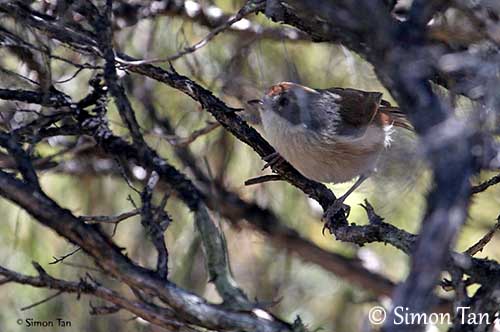
Fr: Mohoua pipipi
Ang: Pipipi or New Zealand Brown Creeper
Maori: Pipipi
All: Graubraunköpfchen
Esp: Agateador de Nueva Zelandia - Mohoua Pipipi
Ita: Rampichino bruno della Nuova Zelanda
Nd: Finschia
Sd: Antipodkrypare
Photographers:
John Anderson
John Anderson Photo Galleries
Simon Tan
PBase Bird galleries
Text by Nicole Bouglouan
Sources:
HANDBOOK OF THE BIRDS OF THE WORLD Vol 12 by Josep del Hoyo-Andrew Elliott-David Christie - Lynx Edicions - ISBN: 8496553423
BirdLife International (BirdLife International)
New Zealand bird status between 2008 and 2012
New Zealand birds and birding (Narena Olliver)
Page family Mohouidae
Page Passeriformes Order
New Zealand Brown Creeper or Pipipi
Mohoua novaeseelandiae
Passeriformes Order – Mohouidae Family
INTRODUCTION:
The New Zealand Brown Creeper or Pipipi is endemic to New Zealand, and is the third member of the family Mohouidae, with the Whitehead and the Yellowhead. Formerly, this species was placed in the monotypic genus “Finschia” but no good reason was found for separating this bird from the mohouas.
These three species have well-adapted long, strong legs and feet for their acrobatic foraging behaviour.
DESCRIPTION OF THE BIRD:
Biometrics:
Length: 13 cm
Weight: M: 13,5 g – F: 11 g
The adult has dark reddish-brown upperparts, including crown, back, rump and tail. The tail shows dark spots in the centre of each rectrice, except on the central pair. The upperwing is dark brown with pale edges on outer primaries.
On the underparts, chin, throat, breast, belly and undertail-coverts are pale greyish-brown with pinkish wash on sides and flanks.
On the head, the crown is reddish-brown whereas the nape is mostly grey-brown. Face, ear-coverts and neck sides are grey. There is a creamy-white stripe behind the eye.
The bill is pale pinkish-grey with grey culmen. The eyes are brown. Legs are pale brown and feet are pale pinkish-grey.
Both sexes are similar.
The juvenile has duller head pattern and conspicuous yellow gape.

RANGE:
The New Zealand Brown Creeper or Pipipi is present on South island and Stewart Island, and on some adjacent islands.
HABITAT:
The New Zealand Brown Creeper or Pipipi frequents native forests of Nothofagus and Leptospermum, plantations of pines (Pinus), second growth, scrub, willow, gorse and broom. It can be found from sea-level to tree-line.
CALLS AND SONGS: SOUNDS BY XENO-CANTO
The New Zealand Brown Creeper or Pipipi gives harsh chattering contact calls within a flock, “zicks” and also “churr, churr, churr”. It also utters rapid metallic trills interspersed with musical notes. The female gives rapid sequences of short notes. These sounds are very similar to those of the Yellowhead.
BEHAVIOUR IN THE WILD:
The New Zealand Brown Creeper or Pipipi is an insect-eater, but it occasionally takes some fruits, especially during autumn.
Invertebrates include beetles, moths, caterpillars and spiders. They are taken from leaves and branches in the canopy. On larger trunks and branches, it searches for hidden insects in the loose bark.
Like the two other Mohouidae species, it often forages by hanging upside down. It rarely forages on the ground, but mostly from two metres above the ground to the canopy.
The New Zealand Brown Creeper or Pipipi is vocal all year round, usually while foraging and feeding in the canopy, or while in flocks, and during the breeding season. Outside the breeding period, they form large, noisy groups, and often join mixed-species flocks. They are silent only during the late summer moult.
During the breeding season, the monogamous pairs are territorial and defend their area. Some disputes may occur, involving males only with males and females with females. They may hold each other with the feet and peck. They sometimes fall to the ground and continue their fight there. Between neighbours, some displays occur too. They sing in unison while approaching and retreating.
Male and female performs courtship displays. Long chases of several minutes are observed, involving the male hopping through the vegetation with quivering wings, while pursuing the female. Courtship feeding by male to female is reported too. Both mates sing before the egg-laying.
The New Zealand Brown Creeper or Pipipi is sedentary and only performs some altitudinal movements when birds from high altitude forests reach lower areas in winter.
REPRODUCTION OF THIS SPECIES:
The breeding season occurs between September and February, with peak of laying in early October, and a second peak in late November (renesting attempt).
The nest is built by the female. This is a compact, deep cup-shaped structure made with plant matters such as bark, twigs, moss and leaves. The cup is lined with grass, wool and feathers.
The nest is placed among the dense foliage in the forest canopy, occasionally in low trees and shrubs, between one and ten metres above the ground.
The male often remains close to the female during the nest building and the beginning of the laying.
The female lays 2-4 white or pinkish eggs with darker markings. She incubates alone during 17-21 days and broods the chicks. Both parents feed them.
The juveniles fledge about 20 days after hatching, and are independent between 35 and 65 days after fledging.
The nest of the New Zealand Brown Creeper or Pipipi is often parasitized by the Long-tailed Cuckoo.
PROTECTION / THREATS / STATUS:
The New Zealand Brown Creeper or Pipipi is locally common in its range, but its habitat has reduced after clearance of forest and deforestation. Introduced predators such as rats and stoats are nest predators and take eggs and chicks.
However, the population is suggested to be stable, and this species is currently evaluated as Least Concern.
